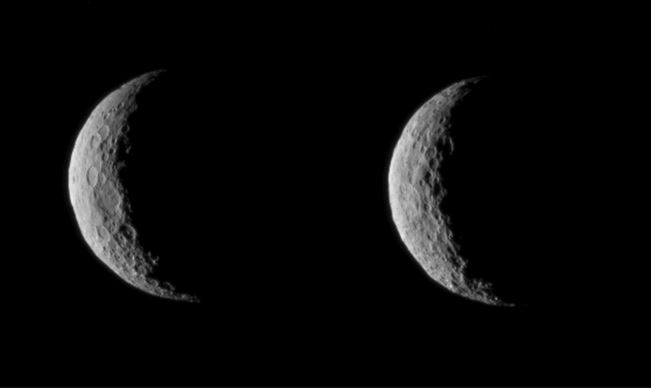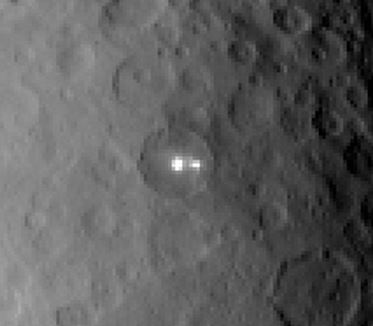Marking a milestone in space exploration, NASA’s Dawn probe is now orbiting Ceres, the first spacecraft to orbit a dwarf planet. At about 04:39 PST (12:39 GMT) on Friday, at a distance of 38,000 miles (61,000 kilometers) from Ceres, Dawn was captured by the dwarf planet’s gravity.
According to NASA, at 05:36 PST (13:36 GMT), mission controllers at its Jet Propulsion Laboratory (JPL) in Pasadena, California, received a signal from Dawn that it was healthy and thrusting with its ion engine, meaning that it had entered orbit as scheduled.
Marc Rayman, Dawn chief engineer and mission director at JPL, said:
“Since its discovery in 1801, Ceres was known as a planet, then an asteroid and later a dwarf planet. Now, after a journey of 3.1 billion miles (4.9 billion kilometers) and 7.5 years, Dawn calls Ceres, home.”

As Dawn positions itself into orbit, its trajectory takes it to the dark site of Ceres, providing these crescent views, which were captured on March 1. (Image: NASA JPL)
Dawn can boast of two firsts:
1. The first mission to orbit two extraterrestrial targets. From 2011 to 2012, it explored Vesta, the giant asteroid, and sent thousands of images of that distant world.
2. The first to visit a dwarf planet, which in this case is Ceres.
Ceres and Vesta are the largest bodies in the solar system’s main asteroid belt, which orbits the Sun between Jupiter and Mars. Ceres has a diameter of 950 km (590 m) and contains approximately one-third of the mass of the asteroid belt.
Dawn’s most recent images of Ceres were taken on March 1st, which show it as a crescent mostly in shadow, because the probe’s trajectory put it on the side of the dwarf planet that faces away from the sun until mid-April.
When Dawn emerges on Ceres’ light side, JPL scientists will receive even-sharper images as it spirals to closer orbits around the dwarf planet.
Chris Russell, principal investigator of the Dawn mission at the University of California, Los Angeles (UCLA), said:
“We feel exhilarated. We have much to do over the next year and a half, but we are now on station with ample reserves, and a robust plan to obtain our science objectives.”

What are the two bright lights in that crater on Ceres’ surface?
Now that Dawn is nearer to Ceres, perhaps we can find out what those mystery bright lights are on its surface. In February, Dawn took a picture showing two bright lights next to each other in a crater basin.
Researchers suggest they might be plumes of ice volcanoes, or perhaps the result of impacts that exposed some of what is under the surface.
Discovered by a Sicilian clergyman and named after a goddess
Ceres was discovered by Father Giuseppe Piazzi in Palermo, a Sicilian astronomer in Palermo in 1801. It was first considered a planet.

A portrait of Father Giuseppe Piazzi pointing at Ceres, his new discovery. (Image: Palermo Astronomical Observatory)
As more objects were found in the same region, it was relegated to dwarf planet status.
A dwarf planet is an object that orbits the sun that is large enough to be spherical by its own gravity, but is not gravitationally dominant in its orbital area, and is not a moon.
The Jet Propulsion Laboratory says:
“Ceres was initially classified as a planet and later called an asteroid. In recognition of its planet-like qualities, Ceres was designated a dwarf planet in 2006, along with Pluto and Eris.”
Father Piazzi named the celestial body “Ceres”, after the Roman goddess of agriculture and harvests. Its craters have mythological names of gods and goddesses of vegetation and agriculture.
NASA Video – Dawn approaches Ceres orbit
